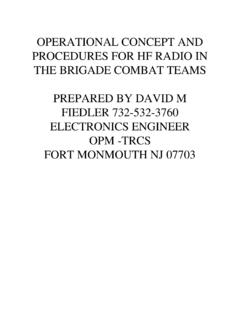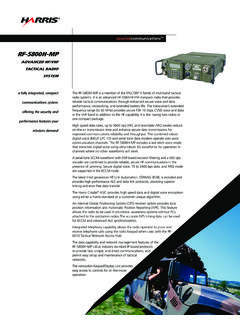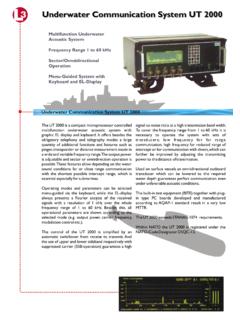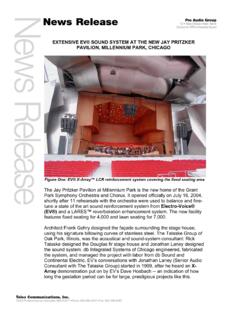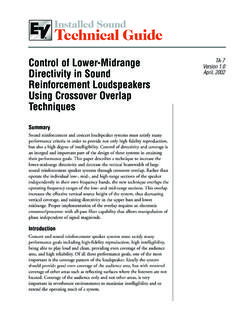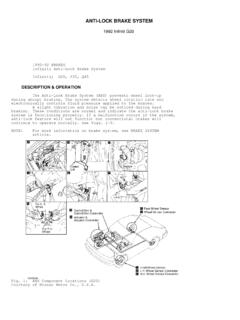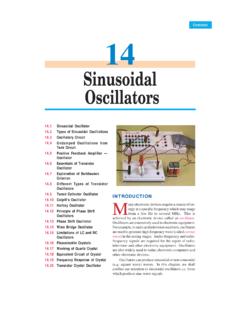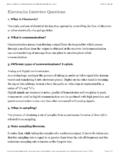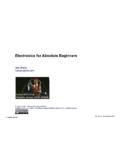Transcription of DD 1 INSTRUCTION BOOKLET - PDF.TEXTFILES.COM
1 DD 1 INSTRUCTION BOOKLET CONTENTS PAGE 1 Discussion of Diversity Action 2 Antenna Recommendations 3 4 5 Operating Suggestions 6 7 8 9 Rejecter Theory and Operation 10 11 12 Four Curves on Rejecter Operation 13 Selectivity Curve, Sensitivity Curve, S units, M/V input curve. 14 Image ratios curve 15 characteristics curve, Audio Fidelity Curve, Overall Fidelity Curve 16 Functional Schematic of Receive DISCUSSION OF DIVERSITY ACTION The advantages to be gained from diversity reception with the model DD1 can best be appreciated by a general understanding of diversity action. Before describing this new receiver in detail, it might be well to briefly review the principles of diversity reception with its benefits as compared to the best single-receiver methods. The principle improvement is, of course, in the reduction of fading. Fading is the result of several waves from the same transmitter arriving at the receiver over different paths.
2 The signal delivered at the output of the receiver is the resultant of the several waves which arrive over paths differing in direction and length. Additionally, these waves upon reaching the receiver are of varying amplitude and phase. Fortunately for our solution to the problem of fading, a signal does not fade identically in two antenna locations at the same instant - even when the two antennas are spaced a relatively small distance apart, or when they are near to each other and in different planes of polarization. What is happening is that the phase angle between waves arriving over varying paths is continuously rotating. When the amplitude is the same in two waves and the signs are opposite, a condition of cancellation, or zero signal, takes place. (We have all experienced the condition of a signal taking a rapid and vicious dive into the noise level). Diversity reception takes advantage of this vulnerable spot in fading's armor.
3 The basic idea is to pick up the signal waves on two different antennas and then combine the signals in a common receiver circuit. While it would be convenient to couple these various antennas to our receiver the result would not be the correct answer, With signals of various phase differences arriving over separate antennas it would still be possible to have complete cancellation of the input to the receiver if the signals on each of the antennas were of equal amplitude but directly out of phase. Because of this condition it is impossible to obtain diversity action through the use of several antennas on one receiver. The only place where combining the signals should take place is in the output of the final detector where we have the rectified envelope of the signal to work with, The final detector outputs of the two receiver sections are tied together across the common load of the 6J5 audio amplifier.
4 Combining the signals after rectification results in audio output which will be the average of the two signals. By virtue of the common , the receiver with the greater signal input takes control of the gain of both receivers and supplies practically the total output. The gain of the other receiver, at that instant of time, is so reduced that the noise it would otherwise contribute is made negligible. The resultant signal-to-noise ratio is that of the particular receiver in control at that instant and results in a considerably higher average signal-to-noise ratio than can be obtained with the single receiver method of reception. In addition, selective fading, or that phenomena which occurs when the carrier fades and the side bands remain at their original level with attendant distortion, is greatly minimized. The reason for this is clear when we understand that the receiver in control at any instant is the one which is delivering the greatest signal to the amplifier.
5 The Hallicrafters Dual Diversity receiver, model DD1 differs from the usual commercial installation in that instead of using separately tuned receivers with individual high frequency oscillators, a common oscillator is used which feeds the first detectors of each of the two receivers. This eliminates the expensive precautions taken in the multi-receiver system to keep the high-frequency hetrodyne oscillator of one receiver from feeding into the other antenna or input circuits. Additionally, with separate oscillators it is practically impossible to obtain perfect synchronism for any length of time. In addition to reducing fading, diversity reception also reduces heterodyne interference in the reception of telephone signals. This may be considered as a species of phase selectivity peculiar to the diversity system, irrespective of its frequency selectivity characteristics. When the audio frequency outputs representing the envelopes of two modulated signals are combined in the audio Load circuit, they will add arithmetically.
6 However, beat frequency heterodyne products from an interfering carrier will add up vectorally. Hence, with the dual diversity system the interference to signal ratio will, at worst, be the same as with a single receiver when the heterodyne outputs of the two detectors are in-phase aiding and of equal amplitudes. Under all conditions, the beat-note products will have a tendency to cancel each other. The combined beat-note output may be reduced to zero when the separate beat-note products are of equal amplitude and opposite phase, Since the relative phase of the interfering heterodyne outputs of the two detectors depends on the radio-frequency phase relationship at the inputs of the receiver, and since this relationship is likely to shift continually, the average heterodyne interference is considerably reduced. The Hallicrafters Model DD1 Diversity system of reception does four important things: 1.
7 Elimination or great reduction of fading in high frequency reception, 2. An average increase in signal strength better than that obtainable with any single receiver, 3. Greatly improved signal to noise ratio. 4. Reduction of heterodyne beat-note interference to a marked degree. The Model DD1 overcomes so many handicaps attendant with normal methods of high frequency reception as to represent a receiving system without a parallel. ANTENNA RECOMMENDATIONS As previously mentioned, diversity action depends on the fact that a radio signal will not fade in two antenna locations at the same instant. Antenna systems used commercially for diversity reception are spaced by thousands of feet. While such an arrangement affords the ultimate in antenna design, practically such an installation represents an impossible installation problem for the normal user of the DD1 receiving system. Additionally, practice has shown that satisfactory diversity action is afforded by having the two antennas separated only a quarter to a half- wave length apart.
8 Suffice to say, regardless of the type of antenna system you should choose to use, diversity action will be better when the two antennas are separated by as great a distance as possible. At this point it might be well to bear in mind that no one aerial, regardless of type, will work at peak efficiency throughout the tuning range of the DD1 receiver. The most practical antenna system for general coverage reception will be that consisting of two inverted "L" antennas approximately 100 feet long overall, Fig. 1A. Running these two wires at right angles to one another will give very satisfactory pick-up in a location where the noise level is fairly low. Considering the fact that the antenna input impedance of the model DD1 and the average terminating impedance of the single wire type of antenna, at high frequencies, is approximately 400 ohms, a good match Is effected. NOTE - When using this type of antenna the jumper should remain connected between A2 and G, or ground.
9 Where reception on the short wave broadcast channels is most desired, two of the commercially available "all wave doublets' erected at right angles to one another and spaced as far apart as possible will provide excellent diversity reception on these frequencies. However, it might be well to point out at this time that in no case should the twisted pair transmission Line as supplied with this all wave type of antenna be connected directly to the diversity. Only through the use of the matching transformer supplied with these kits can a satisfactory match between the 72 ohm impedance of the twisted pair and the 400 ohm input of the receiver be attained. A serious mismatch with a resultant loss of sensitivity and poor reception will occur if a direct connection is made. If you should wish to give preference to any one frequency your logical choice would be an aerial cut one half wave length long and coupled to the diversity by means of the "P" matching stub and the 440 ohm open wire line.
10 A 440 ohm line is conveniently constructed using #10 wire separated by 2" glazed porcelain spacers. The length of the half wave flat top and dimension for the "Y" matching stub may be determined by referring to graph "A" and Fig. 1 B respectively. In view of the numerous types of antennas that can be constructed these suggestions cover only the most practical and easily erected systems. All three types have demonstrated their worth over a period of years. It is to your advantage to erect as efficient an antenna system as possible in order to enjoy the capabilities of the DD1 receiving system to the fullest extent, NOTE 1 The antenna lead-ins should be kept as far apart as possible when entering the receiving position and should not be allowed to parallel one another unless separated by at least 10 feet. NOTE 2 Unlike the average receiver, the DD1 requires a good ground connection.
